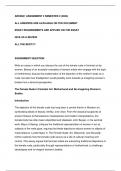ARH2601 ASSIGNMENT 2 SEMESTER 2 (2024)
ALL ANSWERS ARE AVAILABLE ON THE DOCUMENT
ESSAY REQUIREMENTS ARE APPLIED ON THE ESSAY
GIVE US A REVIEW
ALL THE BEST!!!!
ASSIGNMENT QUESTION
Write an essay in which you discuss the use of the female nude in feminist art by
women. Byway of an example/ examples of women artists who engage with the topic
of motherhood, discuss the problematics of the depiction of the mother’s body as a
nude, but also how thisdepiction could possibly work towards re-imagining women’s
bodies from a feminist perspective.
The Female Nude in Feminist Art: Motherhood and Re-imagining Women's
Bodies
Introduction
The depiction of the female nude has long been a central theme in Western art,
symbolising ideals of beauty, fertility, and virtue. From the classical sculptures of
ancient Greece to Renaissance masterpieces and modern interpretations, the
female body has often been objectified and idealised. John Berger, in his seminal
work Ways of Seeing, critiques the traditional representation of women in art as
subjects of the male gaze, arguing that these depictions reduce women to objects of
male pleasure. Lynda Nead, in The Female Nude: Art, Obscenity, and Sexuality,
further explores how the female nude serves as a site of cultural meaning and
control. This essay argues that feminist artists are subverting traditional depictions of
the female nude, particularly through representations of motherhood, to challenge
stereotypes and re-imagine women's bodies.
, Traditional Depictions of the Female Nude
Historically, Western art has idealised the female nude, often portraying women as
embodiments of beauty and virtue. In ancient Greece, female nudes were celebrated
for their form and proportion, reflecting ideals of physical perfection. During the
Renaissance, artists such as Titian and Botticelli continued this tradition, presenting
the female body as an object of admiration and desire. Berger’s analysis reveals that
these representations are deeply entwined with the male gaze, where women are
depicted as objects to be looked at and judged. Nead expands on this by examining
how these depictions reinforce cultural meanings, often reflecting and perpetuating
societal views about gender and sexuality.
Feminist Critique and Resistance
The feminist art movement emerged as a response to these traditional
representations, seeking to challenge and reframe how women are depicted.
Feminist artists reject the notion of the female body as merely an object of male
desire, instead emphasising women's experiences and perspectives. One key
strategy has been to present the female body in ways that resist objectification, often
by portraying it in unidealised, raw, and authentic forms. A significant area of focus
has been the representation of motherhood, where feminist artists address the
complexities of female experience beyond traditional stereotypes.
Case Studies: Feminist Artists Depicting Motherhood
Käthe Kollwitz is a notable example of an artist who redefined the depiction of
motherhood. Kollwitz, a German artist known for her powerful prints, drawings, and
sculptures, often explored themes of suffering and resilience. In works such as
"Mother with Dead Child," Kollwitz presents a raw and poignant portrayal of maternal
grief. Her depiction challenges the idealised images of motherhood by focusing on
the emotional and physical realities of a mother’s experience. This portrayal subverts
traditional nudes by emphasizing the strength and vulnerability inherent in the
maternal role.




